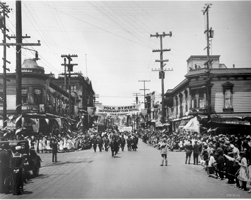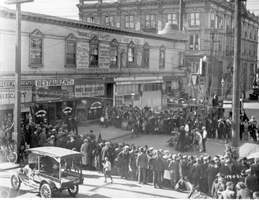Erich Von Stroheim’s
Greed Location Survives In San Francisco
The stately Victorian at  1923, it was the focus of intense media
attention, a magnet for scores of magazine reporters. Today, it is
distinguished by being the only major surviving set from Greed, the most
brilliant, innovative, and controversial
1923, it was the focus of intense media
attention, a magnet for scores of magazine reporters. Today, it is
distinguished by being the only major surviving set from Greed, the most
brilliant, innovative, and controversial
Erich Von Stroheim was the
film’s director, a man who was best known as “the man you love to hate” for his
numerous screen portrayals of Teutonic villains.
The central
character is a self-taught dentist named McTeague
(Gibson Gowland). When his wife Trina (Zasu Pitts) wins $5,000 in a lottery, their life begins to
unravel.
Von Stroheim insisted that the movie be shot on location using
real buildings, not the standard breakaway sets. The main set was the Victorian
at 601 Laguna, which the director found perfect for his needs. A second floor
room that overlooked Laguna and Hayes was transformed into McTeague’s
Dental Parlor, complete with garish gold tooth sign. The movie was set in the
decades before World War I, so the Victorian was festooned with beer and wine
ads. Since this was the height of Prohibition, special permission had to be
granted for such ads, however bogus, to be publicly displayed.
Realism became an obsession for the director. Hidden
cameras often included “real” people in many scenes. In one celebrated
incident, Zasu Pitts as Trina discovers a murder in
an alley near the Victorian. While Von Stroheim’s
hidden camera rolled, Pitts ran out into Laguna in character, frantically
flagging down passersby for help. A real crowd gathered, the police were
summoned, and a reporter phoned in the “homicide” to his editor. In another
incident, a car was reported for almost “running down” a man as he boarded a
streetcar. The man was an actor, the vehicle Von Stroheim’s
camera car.
Stroheim’s
camera car.
Von Stroheim ended up with a
film that was somewhere between 42 to 45 reels in length—about 9 hours long. Greed
was started as a Goldwyn Studios picture, but by the time it was finished
Goldwyn had merged with a new entity, Metro-Goldwyn-Mayer.
Studio chief Louis B Mayer hated the picture, and
eventually it was cut to what was termed a more suitable “commercial
length”—some 10 reels. It was this fragmentary version that was released in
December, 1924
An appalled and distraught Von Stroheim
disowned his mutilated “offspring,” calling it the “skeleton of my dead child.”
By most reports the edited footage was destroyed, melted down for its silver
content.
Greed became celebrated as a kind of lost American epic, one of the greatest films ever produced. In 1999 a ‘restored” version of the movie was aired by Turner Classic Movies. This 239 minute version—99 minutes longer than the original 1924 release—was fleshed out with a extensive montage of stills.